Avast Q4/2023 Threat Report


Foreword
Welcome to the new edition of our report. As we bid farewell to the year 2023, let’s briefly revisit the threat landscape that defined the past year. In 2023, the overall number of unique blocked attacks surged, reaching an unprecedented milestone of more than 10 billion attacks and a remarkable 49% increase year-over-year. This staggering figure, once considered unimaginable, now reflects the harsh reality of our digital landscape. The intensity of these attacks peaked in the final quarter, with a 17% quarter-on-quarter increase, and a monthly average exceeding 1.2 billion attacks.

Q4/2023 was an exceptionally eventful period marked by a myriad of cyber threat developments. Our featured story navigates the intricate PDF threat landscape, unveiling the surge in digital document deception. Threat actors capitalized on PDF files, weaving a complex web of attacks ranging from dating scams and phishing attempts to sophisticated password stealers exemplified by AgentTesla.
In a notable turn of events, this quarter marked the (predicted by many) reappearance of Qakbot, previously dismantled by the FBI. Despite law enforcement efforts, Qakbot resurfaced in December, revealing intriguing overlaps in distribution with Pikabot. Additionally, the sextortion bot Twizt expanded its repertoire by incorporating brute forcing of VNC endpoints.
In a quarter filled with significant developments, a noteworthy trend emerged in the realm of info-stealers. While these threats experienced a slight uptick, what sets this period apart is the
inventive abuse of the Google OAuth API for recovering authentication cookies by Lumma, Rhadamanthys, and other stealers. This novel approach significantly amplifies the impact of their malicious activities.
While there was an overall decline in coinminers, a staggering 250% quarter-on-quarter surge in malicious coinmining in the USA, propelled by the widespread dissemination of XMRig, stood out. Furthermore, adware on desktop maintained a heightened activity level, employing new tricks such as swift DNS record switches for ad servers.
We also observed a subtle uptick in ransomware attacks, featuring prominent groups like LockBit and ALPHV/BlackCat in the headlines. Meanwhile, law enforcement and cybersecurity entities counteracted, exemplified by the release of free decryption tools for Babuk-Tortilla and BlackCat.
Notably, a year after the takedown of the NetWire RAT, its eradication was affirmed. However, it was swiftly replaced by prominent RATs, but also new ones such as zgRAT, Krasue, or SugarGh0st.
Web threats continued to dominate, with scams, phishing, and malvertising ranking as the top threat types overall. The use of malicious browser push notifications escalated, becoming a preferred tool for scammers across various domains, from adult content sites to technical support scams, and financial frauds. Deepfake videos, especially those endorsing investment scams, displayed a heightened level of sophistication, challenging the ability to distinguish between real and fabricated content. Dating and romance scams, affecting approximately one in 20 of our users every month, showcased a global reach, expanding beyond western countries to target the Arab states and Asia. With Valentine’s Day approaching, an upward trend in these scams is anticipated. Furthermore, the conclusion of the year saw a surge in fake e-shops masquerading as renowned brands, leading unsuspecting victims into phishing traps.
Furthermore, the mobile threat landscape continued to evolve, witnessing the resurgence of the Chameleon banker and the insidious spread of SpyLoans on the PlayStore, posing serious threats, including physical violence blackmail.
Finally, as we venture into 2024, we anticipate a dynamic year ahead. Our team has ventured into the realm of predictions for 2024, foreseeing the evolving trends in cyber threats. While we hope our predictions do not come to fruition, and the digital space becomes safer than the close of 2023, your safety remains our top priority. Thank you for your trust in Avast. Enjoy the rest of the report.
Jakub Křoustek, Malware Research Director
Methodology
This report is structured into two main sections: Desktop-related threats, where we describe our intelligence around attacks targeting the Windows, Linux, and Mac operating systems, with a specific emphasis on web-related threats, and Mobile-related threats, where we describe the attacks focusing on Android and iOS operating systems.
We use the term “risk ratio” in this report to denote the severity of specific threats. It is calculated as a monthly average of “Number of attacked users / Number of active users in a given country.” Unless stated otherwise, calculated risks are only available for countries with more than 10,000 active users per month.
A blocked attack is defined as a unique combination of the protected user and a blocked threat identifier within the specified time frame.
Featured Story: The PDF Threat Landscape
In recent times, the cybersecurity landscape has seen a surge in sophisticated malware attacks, with cybercriminals exploiting various vectors to compromise systems and networks. One particularly concerning trend has been the expansion of malware threats through PDF files, a widely used format for document sharing and collaboration.
PDF files have long been a favored medium for sharing documents due to their platform-agnostic nature and consistent formatting across different devices and operating systems. However, this ubiquity has made them an attractive vector for cybercriminals seeking to deliver malware discreetly. Furthermore, PDF attachments are often allowed by default by spam gateways, adding another layer of vulnerability. What’s more, PDF files can be seamlessly opened on both PCs and mobile devices, making them the ultimate delivery payload, further amplifying their appeal as a method for delivering malicious payloads (for example embedding a malicious Word file into a PDF file). Additionally, attackers have begun using bogus URLs, often disguising them through services like the sLinks link shortener, in an effort to bypass antivirus scanners and heighten their chances of successful deployment.
Social engineering is always present in the work of cyberthreats, and we can analyze the typical behaviors used to fool users. One common example is a message that supposedly come from a known company, such as Amazon or some financial entity, with a clearly defined message, such as:
- Your account has been blocked.
- You are given the means to unblock it.
- If you don’t do it in 24 hours, you’ll lose access to your account forever.
The sense of urgency is key in most scams, encouraging victims to act fast and not think twice about the situation. Some other scams are more subtle. The below example poses as Netflix, describing problems with your payment. The simple message – utilizing Netflix branding – indicates an issue with your payment and asks you to update your details:

Once you click the link, you are brought through the steps to enter your financial information, which is then taken by the malicious actors.
Another common scam is the good old lottery scam. In this scam, you’ve been awarded with some lottery prize (without even participating, how lucky!) and you are asked to send some personal details to receive the money. Of course, if you contact the scammers, they will ask you for some money in advance to pay the transfer fees.
Many types of attacks are suitable in PDF format – we have even seen dating scams, because… why not? But PDF-based attacks can also include malware, where the final payload will infect your device, as shown in the following example:

In recent malware campaigns, we have observed a spectrum of threats and scams, ranging from simple ones like lottery and dating scams, through phishing PDFs containing deceptive
information and a link to a phishing page, to complex campaigns delivering more sophisticated threats in JavaScript or embedded objects, culminating in strains such as AgentTesla, DarkGate, GuLoader, IcedID, RemcosRat, Ursnif, Qakbot or various APT groups. We have blocked more than 10 million PDF-based attacks, protecting more than 4 million users worldwide:
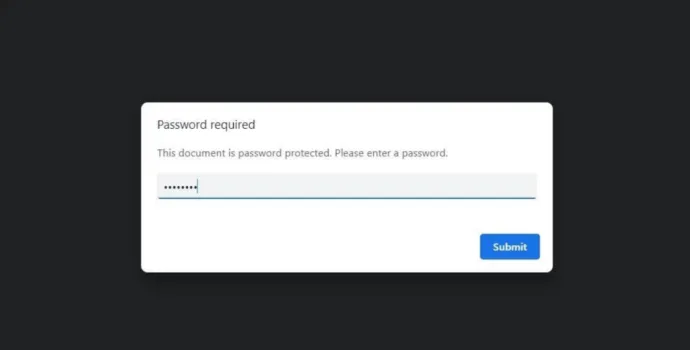
The proliferation of PDF-based cyber threats underscores a significant shift in the tactics of cybercriminals. These attacks, ranging from simple scams to complex malware deliveries, demonstrate the adaptability and cunning of attackers in exploiting trusted digital mediums. PDF files, due to their ubiquity and inherent trust, have become a prime vector for a variety of malicious activities. This trend not only reflects the innovative methods of cybercriminals but also highlights the vulnerabilities inherent in everyday digital interactions.
The examples provided reveal a common thread: the exploitation of human psychology. The sense of urgency, the promise of rewards, and the fear of loss are leveraged to manipulate victims. Moreover, the transition from simple deception to sophisticated malware payloads like AgentTesla, DarkGate, and others, indicates a disturbing escalation in the severity of these threats.
Our analysis shows that, despite the diversity of these attacks, they share a reliance on social engineering and the exploitation of trusted channels. As we have successfully blocked a sizeable number of these attacks, it’s clear that robust cybersecurity measures can be highly effective. However, the battle is not solely technological. Education and awareness play a crucial role. Users must be vigilant, question the authenticity of unsolicited communications, and be aware of the signs of phishing and scams.
Luis Corrons, Security Evangelist
Branislav Kramár, Malware Analyst
Desktop-Related Threats
Advanced Persistent Threats (APTs)
An Advanced Persistent Threat (APT) is a type of cyberattack that is conducted by highly skilled and determined hackers who have the resources and expertise to penetrate a target’s network and maintain a long-term presence undetected.
The final quarter of 2023 has been marked by a series of sophisticated cyberattacks, underlining the persistent and evolving threats posed by Advanced Persistent Threat (APT) groups worldwide. These threat actors have demonstrated their capability and intent to target governmental and military entities, employing a range of techniques from spear-phishing to complex malware.
Spyware Campaign Against Government Entities in the Philippines
In the Philippines, government entities became the focus of a spyware campaign in Q4 2023. This operation utilized an infection chain that incorporated various techniques including spyware, PowerShell and .NET stealers, and spear-phishing as an infection vector. The complexity of this campaign was notable, with each stage employing different methods to infiltrate, monitor, and extract sensitive information from targeted systems. This demonstrates a high level of sophistication and resource investment.
MustangPanda’s Diverse Geographic Targets
MustangPanda, a well-known APT group, extended its operations across several countries, including Vietnam, Australia, the Philippines, Myanmar, and Taiwan. Their operations are marked using the well-known Korplug malware, demonstrating their preference for proven and effective tools in their cyber arsenal. Additionally, this group has been observed utilizing malware written in the Nim programming language. A key technique in their arsenal is the frequent use of sideloading, a method where they load malware by exploiting legitimate software processes.
Attacks on the Pakistani Military
Pakistan’s military was the target of multiple APT groups including groups like Donot and Bitter, signifying the critical importance of military institutions as high-value targets in cyberspace. The attackers employed a combination of spear-phishing as an infection vector, LNK files, and custom backdoors. These attacks underscore the need for heightened cybersecurity measures within military networks, given their attractiveness to a wide range of threat actors.
Lebanese Government Entities Under Siege
The Lebanese government also faced cyber threats, with a threat actor employing a similar range of techniques seen in other attacks, including spear-phishing, LNK files. The infection chain in these attacks was complex, starting with LNK files and moving through various stages including VBScript, BAT files, AutoIT scripts, and eventually leading to the deployment of a custom backdoor. This layered approach to infiltration reflects a strategic methodology designed to evade detection at multiple points, illustrating the lengths to which attackers are willing to go to maintain persistence and control within a targeted network.
Gamaredon’s Aggressive Cyber Campaign in Ukraine
Ukraine has been the target of Gamaredon group’s prolonged and aggressive cyber campaign, marked by a range of intrusive techniques. Their approach includes spear-phishing to gain initial access, followed by the deployment of obfuscated VBScripts and PowerShell scripts, complicating detection efforts. They also use document stealers to illicitly gather sensitive data. Uniquely, the group employs Telegram for disseminating Command and Control (CnC) IPs, a tactic aimed at evading traditional communication surveillance. Further, they spread malware through infected documents and LNK files. In their operations, they also utilize DNS services to acquire IP addresses directly, a technique intended to reduce detection by avoiding the use of domain names. This campaign has resulted in numerous victims, demonstrating Gamaredon’s persistent threat to Ukrainian cybersecurity.
Lazarus
In this quarter, we were monitoring increased activity from the Lazarus group. From our telemetry, it was evident that they continued to utilize ISO files combined with LNK files as an initialization loader for delivering payloads into systems.
In early October, Microsoft observed Lazarus exploiting CVE-2023-42793, a remote-code execution vulnerability impacting various versions of JetBrains, to deploy payloads. Following a successful compromise, they utilized PowerShell to download two payloads from legitimate infrastructure.
We also identified the same toolset being employed to our customers, predominantly those located in Europe.
In December, Cisco Talos reported on a new campaign by Lazarus. In this instance, they were employing a new Dlang-based malware, featuring two Remote Access Trojans (RATs). One of these RATs utilized Telegram bots and channels as a means of communication with the Command-and-Control servers.
This campaign targeted enterprises globally, focusing on those publicly hosting and exposing vulnerable infrastructure to n-day vulnerabilities such as CVE-2021-44228 (Log4j). The sectors primarily under attack included manufacturing, agriculture, and physical security companies.
Luigino Camastra, Malware Researcher
Igor Morgenstern, Malware Researcher
Adware
Adware is considered unwanted if installed without the user’s consent, tracks browsing behavior, redirects web traffic, or collects personal information for malicious purposes such as identity theft.
The rise in popularity of adware can be attributed to its potential for monetization and the dissemination of potentially unwanted programs (PUP) and malware. Moreover, advertisements promoting legal software also employ deceptive adware practices, which verge on the boundaries of scam-like activities. We classify these techniques as annoying and protect our users against this approach. While spreading malware through adware is not the predominant method for infecting victims’ machines overall, our attention in Q4/2023 has been directed toward detecting adware to monitor this potential threat closely.
Adware actors exhibit high flexibility, continuously adjusting their techniques to evade antivirus detection. As a result, it becomes imperative to remain dynamic and consistently adapt to the evolving strategies employed by these actors. The below graph illustrates adware blocks over Q3 and Q4 of 2023. These blocks consist of a diverse array of techniques we actively block and respond to effectively counter the evolving threat of adware – the ongoing cat-and-mouse game.

The global risk ratio of adware in Q4 2023 was similar to the previous quartile. Nevertheless, the prevalence of desktop adware remains significantly elevated. The most affected regions remain South America, Africa, Southeast Asia, and Southeast Europe, as the map below illustrates

Adware Share
One of the more sophisticated adware techniques is switching DNS records for ad servers characterized by remarkably short TTL. Therefore, it is impossible to pinpoint the precise strain of adware. The most prevalent DNS records of ad servers in Q4/2023:
- agriculturalpraise[.]com
- formationwallet[.]com
- plundertentative[.]com
- supportedbushesimpenetrable[.]com
- nutsmargaret[.]com
- facilitypestilent[.]com
- suchbasementdarn[.]com
- usetalentedpunk[.]com
Consequently, a substantial percentage, 54% of adware strains, falls under the category of unknowns. The remaining shares are distributed among other adware strains in the following manner:
- SocialBar (38%)
- DealPly (2%)
- Neoreklami (1%)
Martin Chlumecký, Malware Researcher
Bots
Bots are threats mainly interested in securing long-term access to devices with the aim of utilizing their resources, be it remote control, spam distribution, or denial-of-service (DoS) attacks.
In comparison to the previous quarters, this quarter was roller-coaster with many changes in the landscape. The dust hadn’t even settled on Qakbot’s former infrastructure following its FBI takedown in August 2023 before we witnessed its resurgence in December. The number of our users that have been targeted by Qakbot has doubled in Q4 2023 compared to the previous quarter. While this seems to be a significant increase, it is still dwarfed by its activity before the takedown. Its binaries also went through some overhaul, embracing 64-bit architecture and relying on AES instead of XOR for string encryption. Interestingly, a rather new strain Pikabot exhibited overlaps in distribution related TTPs (thread hijacking and second-stage retrieval) with Qakbot and it was, incidentally, also gaining traction in the landscape, doubling the number of affected users compared to the previous quarter.
Phorpiex’s successor, dubbed Twizt, expanded on its payloads this quarter. Aside from spam/sextortion payloads, we’ve seen previously unseen payloads that have featured code for brute-forcing credentials to VNC (remote desktop sharing protocol) endpoints in both local network and randomly generated IP address for potential publicly accessible endpoints.
The overall risk ratio of bots increased at the end of 2023, partially fueled by Qakbot’s resurgence in December. As for other notable changes in the strain prevalence, we’ve seen a huge drop (-48%) in Amadey infections and a steady increase in Emotet (+14%) and Twizt (+27%) infections.

The last mention of bots goes to NoName056(16) and their DDosia project, which had a rather turbulent quarter. Presumably to hinder tracking attempts by malware researchers, the group has reworked their configuration distribution protocol, including its client authentication. Nevertheless, the first implementation was unstable and ridden with software bugs for both server and client implementations. This has dramatically reduced the project’s efficacy in the short term until these blocking issues were resolved. Shortly after the deployment, the authentication protocol was simplified, and the encryption mechanism was changed shortly due to reported problems with client-attribution statistics. These resulted in reduced rewards for the project’s participants.

As for their general operations, there were not many changes. Attacks on various European and Ukrainian banks were attempted throughout the whole quarter. While the first wave of attacks was met with some success, successive attacks rarely succeeded despite the group’s claims on their Telegram channel. The choice of targets still follows the usual modus operandi, meaning that new configurations were usually spurred by various politicians’ statements directed against Russia and their invasion of Ukraine. Unfortunately, the trend reversal in the number of DDosia project participants still holds with the number of participants linearly increasing throughout the quarter to a little over 16,000 participants. This quarter, the most affected TLDs were .cz, .de, and .fr, each having more than 10% of targeted domains.


Adolf Středa, Malware Researcher
Martin Chlumecký, Malware Researcher
Coinminers
Coinminers are programs that use a device’s hardware resources to verify cryptocurrency transactions and earn cryptocurrency as compensation. However, in the world of malware, coinminers silently hijack a victim’s computer resources to generate cryptocurrency for an attacker. Regardless of whether a coinminer is legitimate or malware, it’s important to follow our guidelines.
When compared to the previous quarter, we observed another decrease in the prevalence of coinminers in Q4/2023, with the risk ratio dropping by 14%. However, even though it is a rather significant drop, we note that it doesn’t mean coinminers are a lesser threat, unfortunately. This is because we also observed rather significant shift in the market share with a decline in web miners giving way to an extensive rise of XMRig and other executable coinminers which are, in general, more dangerous forms of coinmining.
Geographically, we also observed a shift during Q4/2023 where the attacks were more prevalent in specific countries, lowering the global spread with relations to risk ratio.

First and foremost, we measured two huge increases in risk ratio in United States and Turkey by almost 250% and 200%, respectively. We measure another more significant surge in Hungary, Poland, India, and Egypt were the risk ratio increased by 85%, 52%, 50%, and 40%, respectively. On the other hand, users in France and Belgium were less prone to getting infected with coinminers the risk ratio decreased by 80% and 78%, respectively.
In the graph below, we can observe the numbers skyrocket with regards to risk ratio of getting a coinminers in the United States.

As we mentioned before, this quarter shifted more towards traditional executable coinmining instead of web miners. This resulted in XMRig having a significant dominance of a total 64% malware share with a huge 169% increase this quarter. Web miners lost their malware share by 68%, holding a malware share of 19% which is a long-time lowest.
In general, we denote this as a more dangerous threat opposed to the web miners since XMRig and other executable strains usually run on the background of the whole system, not only on the visited webpage. Furthermore, coinminers tend to be bundled with other malware types as well, meaning the scope of the infection might be even bigger in these cases.
The most common coinminers with their malware share in Q4/2023 were:
- XMRig (63.69%)
- Web miners (19.20%)
- CoinBitMiner (2.14%)
- SilentCryptoMiner (2.04%)
- FakeKMSminer (1.47%)
- NeoScrypt (1.20%)
- CoinHelper (0.86%)
Jan Rubín, Malware Researcher
Information Stealers
Information stealers are dedicated to stealing anything of value from the victim’s device. Typically, they focus on stored credentials, cryptocurrencies, browser sessions/cookies, browser passwords and private documents.
Q4/2023 brought a new and interesting stealing capability which was rapidly adapted by information stealers – abusing Google OAuth endpoint for recovering authentication cookies. Lumma for example, a rapidly rising malware-as-a-service (MaaS) stealer, was supposedly the first to advertise and adapt the technique.

Many big information stealer groups, including MaaS players, have already jumped on this new threat. This includes (but is not limited to) Rhadamanthys, Stealc, Meduza, and MetaStealer.
The technique is abusing a Google OAuth “MultiLogin” API endpoint. This endpoint is used for synchronizing accounts across Google services. When the malware decrypts a session token and Gaia ID from the local browser files on the infected device, it is further able to perform a request to the “MultiLogin” API endpoint, recovering the authentication cookie. Note that when this “token and ID” pair is exfiltrated rather than directly used from the victim’s system, the malware authors may use this information on backends instead, trying to avoid AV and EDR monitoring.
Currently, the mitigation is rather limited. According to CloudSEK researchers, the authentication cookie survives even a (sole) reset of the user’s password. In fact, if a user was affected, they need to firstly log out of their Google account to revoke the synchronization OAuth cookie (or sign-out from/kill all active sessions: http://g.co/mydevices), change the password, and log back in.
Unfortunately, these are all reactive steps in a sense that the user needs to know that they were affected. The problem is further underlined by the fact that Google currently doesn’t plan to rework the “MultiLogin” endpoint, or mitigate the API abuse by proactive means.
DNS-based threats
The Domain Name System (DNS) is a decentralized naming system that translates user-friendly domain names into numerical IP addresses for network devices to identify each other. However, this system is now becoming popular for carrying out attacks. Usually, threat actors misuse DNS for these reasons:
- The malware can receive commands and instructions, enabling two-way communication
- The threat actor can deploy an additional payload onto the infected device
- Information stealers can exfiltrate sensitive data from the infected device
- The communication is more obfuscated, rendering it more difficult to track properly
- The communication is usually enabled by default, since the traffic operates on a common port 53
- The traffic may bypass traditional AVs and gateways due to the possible lack of monitoring and scanning
Attackers can use many techniques to achieve this, for example performing DNS tunneling, DNS cache poisoning, DNS fast fluxing, or using rogue/malicious DNS servers, to name a few.
We see threat actors adapting DNS-based techniques already, including notorious malware strains. This includes information stealers like ViperSoftX or DarkGate (also known as Meh) for more obfuscated payload delivery, multi-modular backdoor DirtyMoe for obfuscated communication, or Crackonosh for its update routine.
For further information about DNS-based threats and how we protect our users against them, read our dedicated blog post on Decoded.
Statistics
In Q4/2023, we observed a 6% increase in information stealer activity in comparison with the previous quarter. This increase is mostly due to the rise of Lumma stealer as well as Stealc and by an increase in activity of various online JavaScript scrapers.
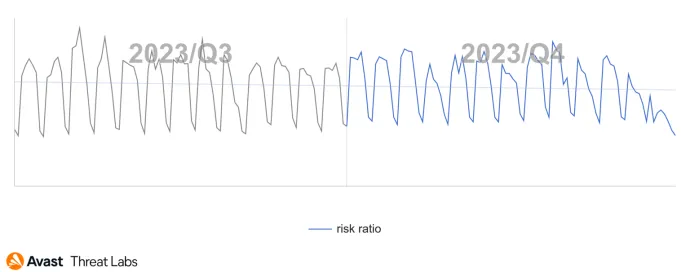
The highest risk of information stealer infections currently exists in:
- Turkey (3.01%) with 46% Q/Q increase
- Pakistan (2.32%) with 6% Q/Q decrease
- Egypt (1.98%) with 3% Q/Q increase
Thankfully, we observed a significant 12% decrease of information stealers’ activity in the United States.
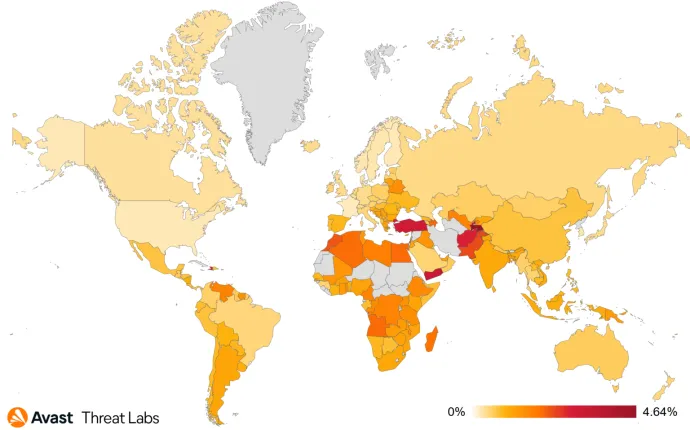
Unsurprisingly, AgentTesla still holds its place as the most popular information stealer, capturing 26% of the global information stealers market share. However, this malware share is lower when compared to the previous quarter due to the 11% decrease. Formbook also experienced a decrease in market share by 10%, having 10% market share now. Unfortunately, various JavaScript scrapers/exfilware were also far more active this quarter, marking 6.08% market share now.
According to our data, Raccoon stealer had another rough couple of months, losing its market share by additional 21%, for a current total of 1.54% market share.
The most common information stealers with their malware shares in Q4/2023 were:
- AgentTesla (26%)
- FormBook (10%)
- Fareit (6%)
- RedLine (4%)
- Lokibot (3%)
- Lumma (3%)
- Stealc (2%)
- OutSteel (2%)
- ViperSoftX (2%)
- Raccoon (2%)
Jan Rubín, Malware Researcher
Ransomware
Ransomware is any type of extorting malware. The most common subtype is the one that encrypts documents, photos, videos, databases, and other files on the victim’s PC. Those files become unusable without decrypting them first. To decrypt the files, attackers demand money, “ransom”, hence the term ransomware.
Hacks, breaches, stolen data. Almost every day, we can read about a new data breach or data extortion campaign from one of the many ransomware gangs. The intensity and frequency are stunning; for example, the LockBit data leak site showed 65 new attacked companies in 15 days (from Oct 23 to Nov 7, 2023). That is more than 4 new companies attacked each day!

As of the time of writing this article, the site lists 217 companies that were allegedly attacked, which makes LockBit the most active ransomware gang worldwide.
However, law enforcement organizations do not sleep either. In a joint operation, the Dutch Police and Cisco Talos recovered a decryption tool of the Babuk ransomware used in the Tortilla malicious campaign. Avast added the recovered private key into its Babuk decryptor, which is now available for download.
Furthermore, several ransomware operations were disrupted in the previous quarter, such as BlackCat / ALPHV, which is the world’s second most active gang.
On Dec 7, 2023, information appeared that BlackCat’s leak site is down. Even though BlackCat operators looked like they were repairing the site, one day later, it appeared that the FBI was behind the outage of the data site:

Ten days later, the Department of Justice officially confirmed that the ransomware gang operation was disrupted, and the site was seized. The leak site now shows information about successful law enforcement operation done by the FBI:

Good employees are a scarce resource; that applies to the dark side employers as well. Hence, as soon as the rumors about BlackCat began, LockBit operators started to recruit the members of the BlackCat gang.
The disruption operation did not stop BlackCat, however. New organizations have been attacked by the gang already in 2024.
Statistics
The following stats show the most prevalent ransomware strains among our userbase. Percentages show the malware share of each strain:
- STOP (17%)
- WannaCry (16%)
- Enigma (9%)
- TargetCompany (4%)
- Cryptonite (2%)
- LockBit (1%)
This quarter, Enigma is the highest jumper, going up from 1% to over 9%. The complete world map with risk ratios is as follows:
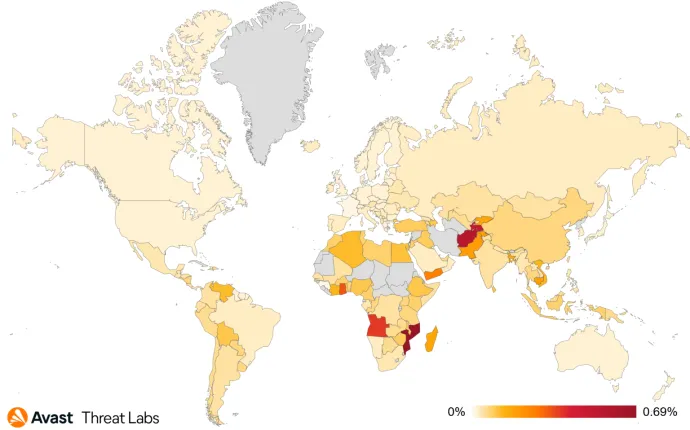
Since the previous quarter, the risk ratio in our user base shows a slight increase:

Ladislav Zezula, Malware Researcher
Jakub Křoustek, Malware Research Director
Remote Access Trojans (RATs)
A Remote Access Trojan (RAT) is a type of malicious software that allows unauthorized individuals to gain remote control over a victim’s computer or device. RATs are typically spread through social engineering techniques, such as phishing emails or infected file downloads. Once installed, RATs grant the attacker complete access to the victim’s device, enabling them to execute various malicious activities, such as spying, data theft, remote surveillance, and even taking control of the victim’s webcam and microphone.
Things in the realm of remote access trojans did not change much in Q4/2023. Regarding the daily activity of RATs, the statistics show a slightly decreasing trend when compared to Q3/2023 but this might be due to the holiday season when targeted users and RAT operators alike enjoy the time off.
An exciting event this year was the takedown of NetWire RAT at the beginning in Q1/2023. Let us look at what effect this takedown had on one of the bigger players at that time. Before the takedown in Q4/2022, NetWire RAT was number 7 on the most prevalent list, taking up over 4% of the malware share among RATs. In Q1/2023 its malware share went down to 3%. The takedown happened at the beginning of March, so it has not yet resulted in much impact. In Q2/2023 the share dropped further to 1.2%, and in the second half of 2023 the malware share stayed at 1% rendering NetWire RAT nearly irrelevant. We do not expect this strain to return to its earlier status.

According to our data, Remcos seems to be the deciding factor in the risk ratio of each country while other strains have much smaller effects. The only exceptions are countries where HWorm is spread which is mainly the Middle East and Afghanistan, Pakistan, and India. As usual, the highest values of risk ratio are in Afghanistan, Iraq and Yemen and the factors are the activity of HWorm and to a far lesser extent the activity of njRAT. The largest increase in risk ratio in this quarter was seen in Romania (78%, Remcos and QuasarRAT), Lithuania (49%, Remcos, njRAT and Warzone) and Czechia (46%, Remcos and njRAT). North Macedonia, Uruguay and Portugal are countries with the largest decrease in risk ratio by -50% and it correlates to decreased activity of Remcos.

We have tweeted about one of the Remcos campaigns tricking users into installing fake Adobe Reader updates. Remcos was very active in October and then somewhat slowed down in November and December. We have also published a tweet about another campaign using fake updates, this time pushing zgRAT, which according to our data is not very spread otherwise.
AsyncRat, currently number 4 on the top prevalent list, has increased its malware share by 30%. There are also two strains which more than doubled their malware share. One of these is XWorm, which has entered the top 10 list in this quarter. The other is SectopRAT which isn’t as prevalent, however there are reports of it working together with the Lumma password stealer.
The most prevalent remote access trojan strains in our userbase:
- HWorm
- Remcos
- njRAT
- AsyncRat
- QuasarRAT
- Warzone
- FlawedAmmyy
- NanoCore
- Gh0stCringe
- XWorm
The discovery of Krasue was probably the most frequent news topic in December. Krasue is a new Linux RAT discovered by Group-IB. According to their report, this threat has been active since at least 2021 targeting organizations in Thailand. The malware holds a rootkit to hide its presence on a system, more specifically it contains 7 precompiled versions for various kernels. Another interesting feature is the use of the RTSP (Real Time Streaming Protocol) for C2 communication which is not very common.

The Cisco Talos team recently spotted a new customized variant of Gh0st RAT. They call this variant SugarGh0st. Gh0st RAT is an old RAT with code publicly released in 2008 and over the years it has been frequently used by Chinese-speaking actors. Talos argues that a Chinese-speaking group might be running the current campaign as well although with low confidence. Among the added features compared to the original Gh0st RAT is looking for specific ODBC (Open Database Connectivity) registry keys, loading library files and changes made to evade earlier detections as well as slight modification of the C2 communication protocol. This is interesting evidence that although there are frequent reports of new RATs, the old and reliable are here to stay.
Two more strains were reported by CYFIRMA namely the Millenium RAT and the SilverRAT. The Millenium RAT briefly appeared for sale on GitHub. It is interesting to note that the release on GitHub specified version 2.4 and version 2.5 followed shortly after. We were not able to find any reports or clues towards earlier versions. This might mean that 2.4 was the first version to go public or that it has been flying under the radar until now. CYFIRMA researchers said that this RAT is probably a derivative of the ToxicEye RAT. Regarding its features, it has the full package expected in a commodity RAT including keylogging, stealing sensitive data, and running commands.
SilverRAT seems to be a continuation of the S500 RAT since according to CYFIRMA it was developed by the same authors. This RAT is not new, it was first shared in 2022, but in Q4/2023 a cracked source code was leaked.
Ondřej Mokoš, Malware Researcher
Rootkits
Rootkits are malicious software specifically designed to gain unauthorized access to a system and obtain high-level privileges. Rootkits can operate at the kernel layer of a system, which grants them deep access and control including the ability to modify critical kernel structures. This could enable other malware to manipulate system behavior and evade detection.
The year-long analysis of rootkit activities reveals a persistent stagnation with a subtle descending trend. A minor peak was found in half of Q4/2024, although its significance is minimal.

Notably, China constantly keeps its prominent position as a leader in rootkit activities.
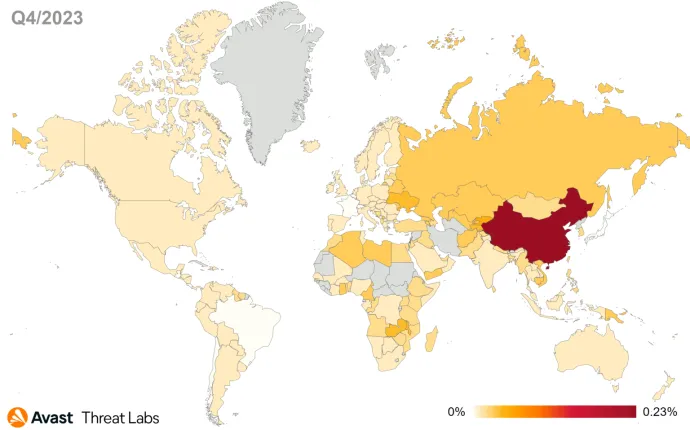
Despite a consistent overall trend, an expansion in affected states is seen, particularly in Europe and Russian regions. Furthermore, a noteworthy occurrence in the Russian territory during the middle of the third quarter extended into the fourth quarter.
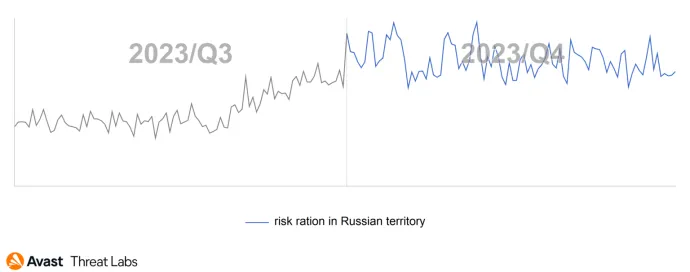
For several years, the dominant rootkit in the wild has been R77, a trend supported by comprehensive data displayed in a graph illustrating the prevalence of all rootkits, with a specific focus on R77.

Projections indicate that R77 will continue to be the most widespread rootkit soon. Its popularity stems from its uncomplicated implementation, operating on a user layer and offering fundamental functions akin to a classic rootkit in layer 0, consequently mitigating the risk of frequent Blue Screen of Death (BSOD) occurrences.
Additionally, approximately 20% of rootkits are standard tools, often utilized as support tools for other malware:
- R77Rootkit (48%)
- Pucmeloun (7%)
- Alureon (5%)
- Bootkor (3%)
- Perkesh (3%)
- Cerbu (2%)
In terms of Linux kernel rootkits, we continue tracking the cyberweapons of APT groups. For instance, we efficiently detected new samples of Mélofée Linux kernel rootkit used by Chinese APT groups.
We want to highlight that we observed similar TTPs in other samples (e.g. Diamorphine kernel rootkit variant) implementing simple functionality (hiding the module and the directories with the malicious content) with its hooks based on KProbes (notice that KHook relies in KProbes), compiled in Amazon Linux distributions and impersonating popular hardware manufacturer modules (e.g. Intel and Realtek).
We will continue tracking lightweight Linux kernel rootkits used by APT groups in the next quarter.
Martin Chlumecký, Malware Researcher
David Álvarez, Malware Analyst
Vulnerabilities and Exploits
Exploits take advantage of flaws in legitimate software to perform actions that should not be allowed. They are typically categorized into remote code execution (RCE) exploits, which allow attackers to infect another machine, and local privilege escalation (LPE) exploits, which allow attackers to take more control of a partially infected machine.
In December 2023, Kaspersky researchers presented more details about Operation Triangulation at the 37th Chaos Communication Congress conference. This attack, targeted at Kaspersky and other entities, utilized several zero-day exploits, starting with an iMessage zero-click. As Kaspersky managed to recover the whole infection chain, this research provides fascinating insights into the techniques employed by highly sophisticated nation state attackers. We learned that the attack featured not one, but two separate validator stages. These were supposed to protect the exploits (and implants) using public-key encryption and ensure that they are only deployed in the targeted environment.
Another interesting finding was that, when the attackers successfully exploited the kernel, they used their newfound privileges to just open Safari to run a browser exploit, essentially having to exploit the same device twice. At the first glance, dropping privileges like this doesn’t make much sense and it’s a bit of a mystery why the attack was designed like this. One theory is that the attackers had two chains and just wanted to take the best from both (the first one had the iMessage RCE, while the second one had the validators), so they decided to take the path of least resistance to connect them. However, we suspect this may also have been a deliberate attempt to protect the most expensive part of the attack: the zero-click iMessage exploit. If a victim discovered the malicious implant and attempted to trace back the infection, they would have most likely not found anything beyond the browser exploit, as no one would be crazy enough to suspect that a browser exploit chain would be initiated from the kernel. So, while the attackers would still get a lot of zero days burned, they would retain the most valuable one. Whatever the reason for the attack approach, one thing is for certain: this attacker must have no shortage of browser zero days if they are willing to risk burning one even when it’s unnecessary.
MTE Support on Pixel 8
Another interesting development happened in October, when Google’s Pixel 8 was released with support for MTE (Memory Tagging Extensions). This represents a significant milestone, as this is the first commercially available device that supports this much-anticipated ARM mitigation.
While it’s not enabled by default, MTE can be turned on as a developer option for testing purposes. This allows developers to test if their application behaves correctly and that MTE does not cause any unexpected errors. The main idea behind MTE is to assign 4-bit tags to allocated 16-byte memory regions. Pointers are then supposed to contain the tag so that the tag can be checked when the pointer is dereferenced. If the pointer tag does not match the expected value, an exception can be thrown. This could potentially mitigate a number of vulnerability classes, like use after frees, as the tag is supposed to be updated between allocations, so the stale pointer’s tag would be outdated at the time the vulnerability is triggered (there is still a good chance that the tag will be valid, though, since there are only 16 possible tag values).
Currently, the actual impact of MTE on the difficulty of exploiting memory corruption vulnerabilities remains unclear; however, it seems like a promising mitigation, which might raise the bar for attackers. It’s also not clear if it will ever be enabled by default, as it will undoubtedly incur some performance overhead and the additional security might not be worth it for the average user. However, it might still come in handy for users who suspect they are targeted by zero-day capable attackers, since at a time when MTE is not widely enabled, its unexpected presence would likely catch most attackers off guard.
Jan Vojtěšek, Malware Reseracher
Web Threats
If we look at the detection statistics for the whole of last year, web threats were the most active category for 2023. Scams of different topics, and different quality thanks to the use of malvertising, have achieved a relatively large coverage worldwide.
Due to this, it is not surprising that scams, phishing, and malvertising formed over 75% of all threats blocked by us during the year.
A powerful and dangerous combination is the scam coupled with malvertising. As we will describe in this section, scammers have started to use many innovations from the ever-developing world of AI in hopes of improving their rate of success.
Scams
A scam is a type of threat that aims to trick users into giving an attacker their personal information or money. We track diverse types of scams which are listed below.
The malvertising business is booming thanks to the willingness of scammers to pay for delivery of their malicious content to victims. One could say that this willingness must come from the fact that scammers are getting their investments back from the money of the scammed users.
An interesting development is the increase in the activity of the scam threat, which started on 20 December and lasted until the end of the year.

The reason for this pre-holiday surge was an unfortunately successful push notification campaign. The campaign’s design, reminiscent of the famous CAPTCHA, encouraged users to allow push notifications to be sent from a given page.

Avast consistently draws attention to the issue of scam push notifications. Last quarter, we warned about a massive increase in malvertising threats, an increase which continued in the fourth quarter of the year.

This promotion allows the scammer to take the user wherever he needs to go. From ordinary porn sites to financial scams, tech support scams, or even phishing sites.
A notable example is the phishing campaign shown below, which had its origin on a similar landing page where it convinced the user to allow sending push notifications. Typically, ads for adult content were then sent from this page. But then came a seemingly authentic ad campaign targeting Spotify users.

The phishing page continued to give the impression that it was a real Spotify page, as presented on the push notification pop-up, particularly the subscription renewal. It asked the user for a username and password, but also for credit card details including the verification code.

Overall, the dividing line between phishing, scam and malvertising is very thin, and statistics are only confirming the common general growth of all these threats.
Financial scams
A big attraction in the world of scams for the fourth quarter was the massive deployment of AI-generated videos in ads for financial/investment scams, which we pointed out and described in more detail in our last report. These videos were initially relatively low quality, but their quality gradually rose to a quite impressive level.
Scammers are still using known faces to lure users and entice people to click on the malicious links. Classics campaigns include the likes of Elon Musk, TV news reporters, and even presidents of countries. These advertisements use prestigious characters from the country where the advertisement is to be displayed. In the following examples, you can see a deepfake of the Czech President or Ursula von der Leyen introducing a new investment platform.

We have also seen advertisements that used video images of famous characters that were embedded in an edited video to create the context for the introduction of a new product, but this is a different approach. Here, the overall impression created is much more believable, thanks to the fact that these generated videos explicitly speak certain text and mention specific names of fraudulent sites.
Peak financial scam activity was observed in mid-November. Toward the end of the year, this activity slowly started to calm down.

We have drawn attention to these ads many times. Typically, they lead to fraudulent sites that aim to promote information from ads and then redirect users to a registration form such as the one shown below.

Dating Scams
Dating scams, also known as romance scams or online dating scams, involve fraudsters deceiving individuals into fake romantic relationships. Scammers adopt fake online identities to gain the victim’s trust, with the ultimate goal of obtaining money or enough personal information to commit identity theft.
In comparison to the previous quarter, a significant global increase in online dating fraud was seen in Q4 2023. However, intriguing shifts in attack patterns and targeted regions have come to light. Notably, despite a temporary decline in the number of scams during the holiday season, perhaps due to individuals being preoccupied with festive celebrations and spending time with loved ones, there are now emerging trends in how and where these scams are being deployed. Attackers have shifted their focus to different countries, marking a distinctive change in their strategies.

The most substantial increase has been observed in the Arab states, including Saudi Arabia, Yemen, Oman, the United Arab Emirates, Kuwait, as well as in Indonesia, Cambodia, and Thailand. This shift in focus might be linked to a broader global trend of increased online interactions and digital connections. The evolving landscape of online socialization and communication has inadvertently created both challenges and opportunities for scammers. As people continue to engage more extensively in online platforms for various reasons, attackers are adapting their strategies and targeting different regions to exploit these shifting patterns of online activity.

Countries in Central Europe and North America continue to face dating scams most, with approximately one in 20 users encountering these threats, on average. The observed decline during the holidays has piqued our interest, and we anticipate a resurgence in scam activities, particularly in the lead-up to Valentine’s Day. The romantic nature of this occasion may make individuals more susceptible to online connections, providing an opportune moment for attackers to exploit emotions and vulnerabilities.

Tech Support Scams
Tech support scam threats involve fraudsters posing as legitimate technical support representatives who attempt to gain remote access to victims’ devices or obtain sensitive personal information, such as credit card or banking details. These scams rely on confidence tricks to gain victims’ trust and often involve convincing them to pay for unnecessary services or purchase expensive gift cards. It’s important for internet users to be vigilant and to verify the credentials of anyone claiming to offer technical support services.
The fourth quarter showed tech support scam activity continued its downtrend that we observed all 2023.
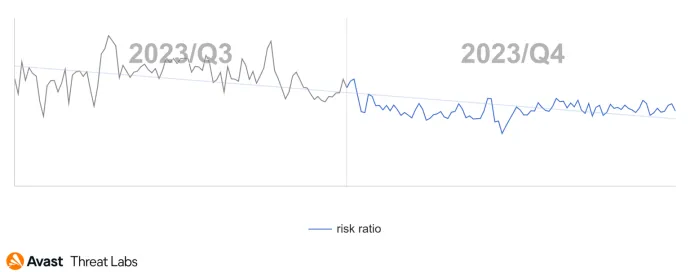
Several countries in which we typically observe significant tech support scam activity register significant declines in risk ratio. There are exceptions, one of which is Spain, which came third in our quarterly ranking. In Spain we see a 42% increase in the risk ratio in Q4 2023.

Our ranking is traditionally dominated by Japan, together with the USA, followed by Spain. Interestingly, last quarter leader, Germany, has fallen back and rounds out our top 6, just behind France.
- Japan 1.08%
- United States 1.02%
- Spain 0.81%
- Australia 0.72%
- France 0.68%
- Germany 0.64%
If we look at the activity graph of Spain. We can see that the main source of activity comes at the end of November.

The Tech Support scam landing pages changes very little. The same techniques are still used to block the user’s browser and force the user to dial the phone number offered. Therefore, the example of the most prevalent landing page shows only minor changes.

Refund and Invoice Scams
Invoice scams involve fraudsters sending false bills or invoices for goods or services that were never ordered or received. Scammers rely on invoices looking legitimate, often using company logos or other branding to trick unsuspecting victims into making payments. These scams can be especially effective when targeted at businesses, as employees may assume that a colleague made the purchase or simply overlook the details of the invoice. It’s important to carefully review all invoices and bills before making any payments and to verify the legitimacy of the sender if there are any suspicions of fraud.
Online Billing: New Frontier for Cybercriminals in 2024
It’s common for internet users to have approximately 80-90 passwords for various services, as reported by LastPass, and cybercriminals take advantage of a simple fact: users must keep track of an unimaginable number of subscription accounts. Additionally, many traditional companies that previously relied on manual service management processes are gradually transitioning their customers to paperless methods, such as online account billing. This shift, primarily a cost-saving measure, is likely to continue in the future, with most customer services moving to online accounts or mobile apps. Attackers are aware of this trend, which has opened new avenues for cybercrime.
One fruitful strategy employed by cybercriminals is to target digital services that have widespread usage. In Q4 2023, we observed a significant increase in one particular type of scam: subscription fraud. Among these, Netflix scams emerged prominently. With Netflix’s user base soaring to over 250 million in 2023, the likelihood of successfully attacking a random subscriber is quite high, especially in the US and Europe where the penetration of these services is generally higher.
The typical Netflix online billing scam attack generally arrives in the form of an email, which is a little more difficult to examine on a small screen. These messages are increasingly tailored to fit the small screens of mobile devices, a trend that aligns with the growing trend of using cell phones to manage one’s entire online presence. Let’s look at what these scams look like:

There are several red flags in the email that should raise alarms. A common thread is the language scammers use, which often create a sense of urgency and sometimes include spelling and grammar mistakes (though less with the increase of AI as a tool to support in scam message creation). The color scheme of such messages is frequently tailored to enhance the sense of urgency, with a strong use of red, yellow, or a combination thereof. For a company like Netflix – which spends enormous amounts on marketing – the design, if examined closely, is not very well-executed. Additionally, companies typically do not ask you to update payment details via a link in the email. These are just the main red flags in this particular example.
Geographically, the countries most affected by these online billing scams are predominantly located in Europe and North America. There are a few exceptions: Australia has the highest risk ratio of 1.52%, and New Zealand is close behind with 1.11%, ranking third.

In Q4/2023, when we examine online billing scam data on a month-by-month basis, we can identify a significant spike during the last week of November. Even the period leading up to Christmas was higher than normal, which might be attributed to the fact that, for many people, Christmas is a time when they report higher-than-usual stress levels, according to the American Psychological Association. As we know, scammers take advantage of people’s vulnerable moments, and the holiday season can often be wrought with. Additionally, buying habits change during the holiday season, which might also contribute to the spike.
The trend line we see in the graph continues to climb throughout the fourth quarter, as seen below.
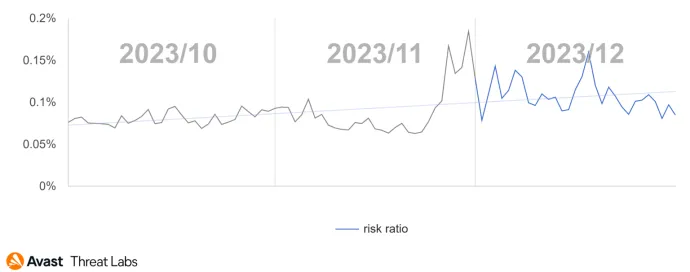
As always, stay vigilant and pay close attention to the emails you receive, especially on your mobile device to help avoid these types of scams.
Phishing: Post-Holiday Phishing Alert in Online Shopping
Phishing is a type of online scam where fraudsters attempt to obtain sensitive information including passwords or credit card details by posing as a trustworthy entity in an electronic communication, such as an email, text message, or instant message. The fraudulent message usually contains a link to a fake website that looks like the real one, where the victim is asked to enter their sensitive information.
As far as phishing is concerned, attackers did not relent in their efforts in Q4/2023. The phishing graph below highlights the overall increase in web threats.

Throughout 2023 we witnessed a wide array of phishing campaigns. During the fourth quarter, there was interesting activity in the category of fake online shops (also referred to as e-shops).
Following the holiday season, a surge of over 4,000 fake e-shops imitating popular brands posed a threat to online shoppers. Scammers exploited post-holiday bargain hunters, making vigilance crucial.

The cyber criminals behind these fake e-shop attacks meticulously mimic renowned brands (including Nike, Adidas, Pandora, Zara, Hilfiger, The North Face and many more) luring consumers with incredibly realistic-looking websites. Their process involves phishing for personal information during a fake login, and the sites often appear amongst the top search results.

In the final stages of the scam, users are coerced into providing personal and payment details, risking exposure of sensitive information.
Tips for safety include verifying website credibility, cautious sale shopping, watching for fraud signals, and keeping security software updated.



Alexej Savčin, Malware Analyst
Branislav Kramár, Malware Analyst
Matěj Krčma, Malware Analyst
Mobile-Related Threats
As we enter the new year, we can look back on an interesting quarter in the mobile threat landscape. While adware continued its reign as one of the most prevalent threats facing mobile users in Q4 2023, we also observed the Chameleon banker making a comeback and taking aim at victim’s bank accounts with new HTML injection prompts, coupled with disabling biometric unlocks that allow it to extract victim PIN and passwords. A first for the mobile sphere, FakeRust remote desktop access applications were also used to make fraudulent payments on behalf of users, leaving them with little recourse in challenging these payments.
In the realm of mobile apps, a new spyware strain, coined Xamalicious, used the open-source framework Xamarin to stay undetected in the PlayStore and take over user devices to steal data and perform click fraud. We observed an unusual double SpyAgent targeting both Android and iOS users in Korea, aiming to extract sensitive information such as SMS messages and contacts. SpyLoans also continued to spread in the PlayStore and was used to extort victims, even threatening physical violence in some cases, breaching the digital and real-world divide.

Finally, another set of malicious WhatsApp spyware mods was distributed to users, interestingly using the Telegram platform.
Web-Threats Data in the Mobile Landscape
As with Q3 2023, we now include web-threat related data in our telemetry for mobile threats. Scams, phishing and malvertising were responsible for most blocked attacks on mobile devices in Q4 2023. We noted a decrease in the percentage share of scams and an increase in phishing and malvertising compared to the previous quarter. These are discussed in more detail in the web-threat sections of this report.

Web-based threats will continue to account for most blocked attacks on mobile devices going forward. For malware applications to initiate their intended malicious activity on Android or iOS, they must be installed by the user and activated by running the application. In most cases, additional permissions must be given to the application to allow full reign of the infected device.
Comparatively, web-based threats are much more likely to be encountered during regular browsing as most mobile device users browse the internet daily. These web threats can be contained in private messages, emails, and SMS but also in the form of malicious adverts, redirects, unwanted pop ups and via other avenues. Blocking web-threat based attacks is beneficial for the security of mobile devices, as malware actors often use them as an entry point to get the payload onto the mobile device of their victims.
Adware remains at the top
Adware threats on mobile phones refer to applications that display intrusive out-of-context adverts to users with the intent of gathering fraudulent advertising revenue. This malicious functionality is often delayed until sometime after installation and coupled with stealthy features such as hiding the adware app icon to prevent removal. Adware mimics popular apps such as games, camera filters, and wallpaper apps, to name a few.
Adware was yet again the most prevalent of the traditional on-device malware threats in the mobile sphere in Q4 2023. Raking in fraudulent advertising revenue while negatively affecting the user experience of victims, these apps use various methods of spread to continue to sneak onto victims’ devices and remain hidden for as long as possible.
HiddenAds was again at the top of the adware list, trailed by SocialBar, a web threat adware that displays aggressive push notifications. Further down the list are MobiDash and FakeAdBlockers that altogether make up the bulk of adware threats facing mobile users this quarter.
On-device adware shares some similarities, with these strains often hiding their icons once installed on user devices to prolong their malicious activity. Some adware has been seen serving advertisements while the screen is off to avoid detection and generate fraudulent revenue. Others are more brazen, displaying full screen out-of-context ads to victims, greatly impacting their user experience as they struggle to identify the source of the annoying adverts.
Methods of spread for adware include third party app stores, fake websites distributing adware games and malicious redirects coupled with false advertising that leads users to download these adware apps.

The risk ratio of adware increased in Q4 2023, and we observed an increase in overall protected users of 14%. This trend is largely due to SocialBar and its increased prevalence on mobile devices, as evidenced by the large spike in the graph, that subsides into the later part of the quarter. Conversely, HiddenAds risk ratio has decreased this quarter.

Brazil, India and Argentina again have the most protected users this quarter. Conversely, Indonesia, India and South Africa have the highest risk ratios, meaning users are most likely to encounter adware in these countries according to our telemetry.

Chameleon banker’s re-emergence
Bankers are a sophisticated type of mobile malware that targets banking details, cryptocurrency wallets, and instant payments with the intent of extracting money. Generally distributed through phishing messages or fake websites, Bankers can take over a victim’s device by abusing the accessibility service. Once installed and enabled, they often monitor 2FA SMS messages and may display fake bank overlays to steal login information.
As is seemingly the trend most quarters, we once again observed a comeback of a previously discovered strain of banker, this time with Chameleon coming back after a several month hiatus with new malicious features added. Remote desktop access applications are abused to perform fraudulent transactions on behalf of victims, followed by the introduction of malicious FakeRust bankers. Continuing the trend from last quarter and despite the new and updated entries, bankers are on the decline in terms of protected users yet again. Cerberus/Alien leads the pack followed by Coper, Bankbot and Hydra.
The Chameleon banker highlighted in the Q2/2023 report is making a comeback with newly added features that allow it more ways to take over and control victim devices. Previously targeting Australia and Poland, it disguised itself as tax or banking applications or crypto currency exchanges. With its re-emergence, Chameleon targets users in the UK and Italy as well and it appears to be primarily distributed by phishing pages disguised as legitimate websites distributing the malware. As with most bankers, Chameleon requires the Accessibility service to perform its full device take over. One of its upgrades allows it to display the Accessibility service prompt using an HTML based pop up on devices running Android 13, a step up from previously used in-app prompts. Once it has full device control, this banker can now disable biometric unlocks for the device and installed applications. This bypass means Chameleon can spy on user PIN codes or passwords that must be used in lieu of biometrics, potentially adding another layer of information theft to its repertoire. The implications of this could be severe if more bankers adopt a similar approach into the future.

In a new trend, remote desktop access applications have been used in attacks targeting mobile user bank accounts. Due to database leaks from popular banks, threat actors have been able to gain access to sensitive victim data that they used in communication with victims. Pretending to be the bank security teams, criminals con victims into downloading the legitimate RustDesk application. After the app is installed, the threat actors request a unique identifier from the victim, with which they took over the device and conducted fraudulent payments on the user’s behalf.
To make the situation worse, this device takeover has made it more difficult for victims to prove fraudulent activity, as it came from their device. RustDesk was removed from the PlayStore as a result, even though the application is not harmful on its own. Following the removal, fake banking websites were used to distribute a continuation of this threat, dubbed FakeRust. Pretending to be bank support websites, they distributed fake support applications that allowed them remote access to devices to steal money as with RustDesk.

For several quarters, we have observed a decline in the prevalence of bankers. We suspect that difficulty in spreading updated and new banker strains is rising, hence the lowering numbers of victims in the past year. It is likely that phishing websites and direct messaging through WhatsApp and other messengers isn’t as effective as widespread SMS message campaigns of the past.

Turkey has the highest risk ratio this quarter, followed by Spain and Singapore. The focus this quarter remained on Europe with less bankers spotted in Australia compared to last quarter.

SpyLoans and Malicious WhatsApp mods
Spyware is used to spy on unsuspecting victims with the intent of extracting personal information such as messages, photos, location, or login details. It uses fake adverts, phishing messages, and modifications of popular applications to spread and harvest user information. State backed commercial spyware is becoming more prevalent and is used to target individuals with 0-day exploits.
Spymax continues to be the most prevalent spyware strain quartering Q4 2023, trailed by SexInfoSteal, RealRAT and WAMods. Several new spyware strains enter the fray this quarter, one even attempting to infect iOS devices to steal user data. Malicious messenger mods for WhatsApp continue their spread as users are advised to refrain from installing messenger mods. Finally, SpyLoans continue to be a blackmailing menace that even threatens users with physical violence if they don’t pay excessive amounts of money to the threat actors.
A new backdoor spyware has also entered the market through the PlayStore. Called Xamalicious, it uses an open-source framework called Xamarin, which can be used to build Android and iOS apps with .NET and C#. The use of the Xamarin framework has aided malware authors in staying undetected and on the PlayStore for extended periods of time. While Xamalicious has been taken down from the PlayStore, many of these apps remain available on third-party marketplaces. Once installed on the victim’s device, it will try to obtain Accessibility privileges with which it downloads a second-stage payload assembly DLL that allows it to take full control of the device. It has been seen installing other malicious apps, clicking on adverts, and stealing sensitive user data. Specifically, it collects device details, location, lists of apps and may access messages as well. We observe Xamalicious mainly targeting Brazil, UK and the US.

A new SpyAgent is also targeting South Korean users through direct messages and phishing websites that mimic legitimate services such as messengers or yoga training apps. Interestingly, this threat targets both Android and iOS. Once downloaded on Android, it tries to steal contact information and SMS messages and can monitor calls, all of which are sent to the malware authors. While on Android, the process for spread is as seen in other spywares, on iOS the threat actors use a third-party tool that allows installing of apps out with the AppStore called Scarlet. Users who already have Scarlet with a certificate set to ‘Trust’ expose their devices to this spyware that can run anytime once installed. Scarlet then collects contact info from iOS users that is likely used for further distribution of the malware or other fraudulent activities.

Our telemetry shows a continued rise in the prevalence of SpyLoans in 2023, fake loan applications that harvest user data that is used to extort victims into sending money to the malware authors. Another round of these applications was present on the PlayStore as reported by ESET.
Despite their removal, these applications are increasingly propagated through SMS messages but also on social media such as TikTok, Facebook and YouTube. Several of these malwares also had fake loan websites set up, giving them the appearance of legitimacy. In some cases, the threat actors also impersonate reputable loan providers. Once installed, the SpyLoan uses SMS verification to check that the user is from a specific country, followed by an extensive and invasive loan application that requires the victim to allow access to their contacts, messages, bank account information, ID cards and photos on their device. Social media reviews highlight the dismay of victims as the malware authors threaten to send sensitive information to their friends and relatives, in some cases even threatening physical harm.

As reported last quarter, we continued to observe malicious mods for popular messengers such as WhatsApp and Telegram in Q4 2023. In an interesting twist, spyware WhatsApp mods were seen distributed through Telegram. Once users install the malicious mod, it sets up monitoring of the device, such as what applications are used, when new messages come in or when new files are downloaded. These events trigger the spy module that starts listening and sends away any interesting information to the malware authors. It then listens for further commands, which may include sending files to a C2 server, recording sound, and uploading contacts and messages among others. It appears these spyware mods are targeting Arabic speaking countries, as the developers set up their C2 servers in Arabic. It is likely we will see more malicious spyware mods for these popular applications going forward.

Spyware has decreased in prevalence this quarter, despite the newly found strains of malicious mods, SpyLoans and others. With this, the risk ratio has also decreased compared to last quarter.

Brazil, Turkey, and the US have the highest numbers of protected users this quarter. However, the risk ratio in all 3 top countries has gone down this quarter. Yemen, Turkey, and Egypt have the highest risk ratios this quarter.
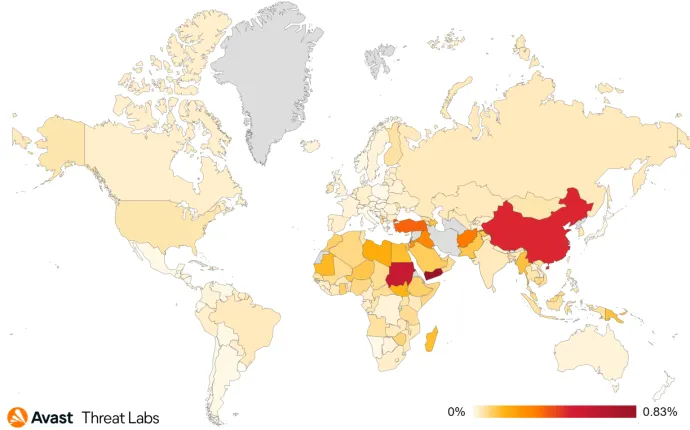
Jakub Vávra, Malware Analyst
Acknowledgements / Credits
Malware researchers
Adolf Středa
Alexej Savčin
Branislav Kramár
David Álvarez
David Jursa
Igor Morgenstern
Jakub Křoustek
Jakub Vávra
Jan Rubín
Jan Vojtěšek
Ladislav Zezula
Luigino Camastra
Luis Corrons
Martin Chlumecký
Matěj Krčma
Michal Salát
Ondřej Mokoš
Data analysts
Pavol Plaskoň
Filip Husák
Lukáš Zobal
Communications
Brittany Posey
Emma McGowan